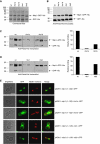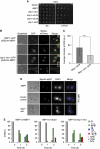Targeting of Nbp1 to the inner nuclear membrane is essential for spindle pole body duplication
- PMID: 21785410
- PMCID: PMC3160662
- DOI: 10.1038/emboj.2011.242
Targeting of Nbp1 to the inner nuclear membrane is essential for spindle pole body duplication
Abstract
Spindle pole bodies (SPBs), like nuclear pore complexes, are embedded in the nuclear envelope (NE) at sites of fusion of the inner and outer nuclear membranes. A network of interacting proteins is required to insert a cytoplasmic SPB precursor into the NE. A central player of this network is Nbp1 that interacts with the conserved integral membrane protein Ndc1. Here, we establish that Nbp1 is a monotopic membrane protein that is essential for SPB insertion at the inner face of the NE. In vitro and in vivo studies identified an N-terminal amphipathic α-helix of Nbp1 as a membrane-binding element, with crucial functions in SPB duplication. The karyopherin Kap123 binds to a nuclear localization sequence next to this amphipathic α-helix and prevents unspecific tethering of Nbp1 to membranes. After transport into the nucleus, Nbp1 binds to the inner nuclear membrane. These data define the targeting pathway of a SPB component and suggest that the amphipathic α-helix of Nbp1 is important for SPB insertion into the NE from within the nucleus.
Conflict of interest statement
The authors declare that they have no conflict of interest.
Figures








Similar articles
-
A ternary membrane protein complex anchors the spindle pole body in the nuclear envelope in budding yeast.J Biol Chem. 2017 May 19;292(20):8447-8458. doi: 10.1074/jbc.M117.780601. Epub 2017 Mar 29. J Biol Chem. 2017. PMID: 28356353 Free PMC article.
-
Nuclear envelope insertion of spindle pole bodies and nuclear pore complexes.Nucleus. 2012 May-Jun;3(3):226-36. doi: 10.4161/nucl.20148. Epub 2012 May 1. Nucleus. 2012. PMID: 22572959 Free PMC article. Review.
-
The Saccharomyces cerevisiae spindle pole body (SPB) component Nbp1p is required for SPB membrane insertion and interacts with the integral membrane proteins Ndc1p and Mps2p.Mol Biol Cell. 2006 Apr;17(4):1959-70. doi: 10.1091/mbc.e05-07-0668. Epub 2006 Jan 25. Mol Biol Cell. 2006. PMID: 16436507 Free PMC article.
-
Characterization of spindle pole body duplication reveals a regulatory role for nuclear pore complexes.J Cell Biol. 2017 Aug 7;216(8):2425-2442. doi: 10.1083/jcb.201612129. Epub 2017 Jun 28. J Cell Biol. 2017. PMID: 28659328 Free PMC article.
-
Karyopherins and nuclear import.Curr Opin Struct Biol. 2001 Dec;11(6):703-15. doi: 10.1016/s0959-440x(01)00264-0. Curr Opin Struct Biol. 2001. PMID: 11751052 Review.
Cited by
-
Duplication and Nuclear Envelope Insertion of the Yeast Microtubule Organizing Centre, the Spindle Pole Body.Cells. 2018 May 10;7(5):42. doi: 10.3390/cells7050042. Cells. 2018. PMID: 29748517 Free PMC article. Review.
-
A ternary membrane protein complex anchors the spindle pole body in the nuclear envelope in budding yeast.J Biol Chem. 2017 May 19;292(20):8447-8458. doi: 10.1074/jbc.M117.780601. Epub 2017 Mar 29. J Biol Chem. 2017. PMID: 28356353 Free PMC article.
-
Sec66-Dependent Regulation of Yeast Spindle-Pole Body Duplication Through Pom152.Genetics. 2015 Dec;201(4):1479-95. doi: 10.1534/genetics.115.178012. Epub 2015 Oct 28. Genetics. 2015. PMID: 26510791 Free PMC article.
-
Nuclear envelope insertion of spindle pole bodies and nuclear pore complexes.Nucleus. 2012 May-Jun;3(3):226-36. doi: 10.4161/nucl.20148. Epub 2012 May 1. Nucleus. 2012. PMID: 22572959 Free PMC article. Review.
-
Yeast centrosome components form a noncanonical LINC complex at the nuclear envelope insertion site.J Cell Biol. 2019 May 6;218(5):1478-1490. doi: 10.1083/jcb.201809045. Epub 2019 Mar 12. J Cell Biol. 2019. PMID: 30862629 Free PMC article.
References
-
- Adams IR, Kilmartin JV (2000) Spindle pole body duplication: a model for centrosome duplication? Trends Cell Biol 10: 329–335 - PubMed
-
- Alber F, Dokudovskaya S, Veenhoff LM, Zhang W, Kipper J, Devos D, Suprapto A, Karni-Schmidt O, Williams R, Chait BT, Sali A, Rout MP (2007) The molecular architecture of the nuclear pore complex. Nature 450: 695–701 - PubMed
-
- Antonin W (2009) Nuclear envelope: membrane bending for pore formation? Curr Biol 19: R410–R412 - PubMed
-
- Araki Y, Lau CK, Maekawa H, Jaspersen SL, Giddings TH Jr, Schiebel E, Winey M (2006) The Saccharomyces cerevisiae spindle pole body (SPB) component Nbp1p is required for SPB membrane insertion and interacts with the integral membrane proteins Ndc1p and Mps2p. Mol Biol Cell 17: 1959–1970 - PMC - PubMed
Publication types
MeSH terms
Substances
LinkOut - more resources
Full Text Sources
Molecular Biology Databases

